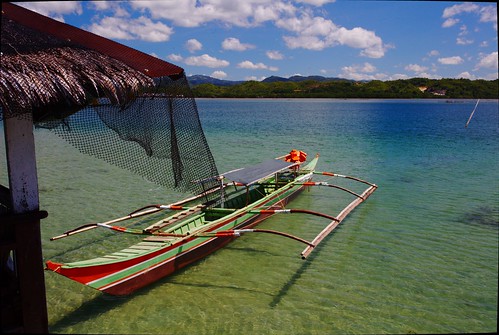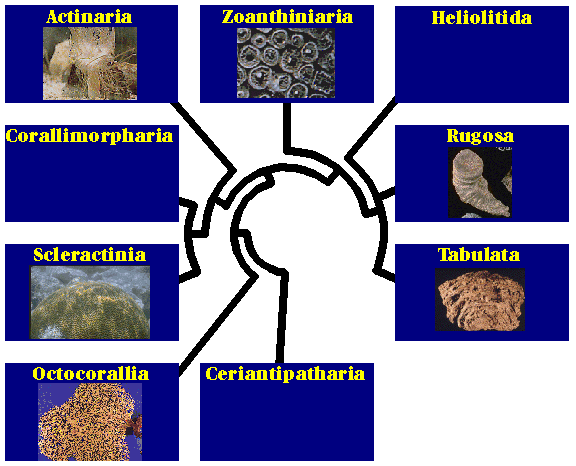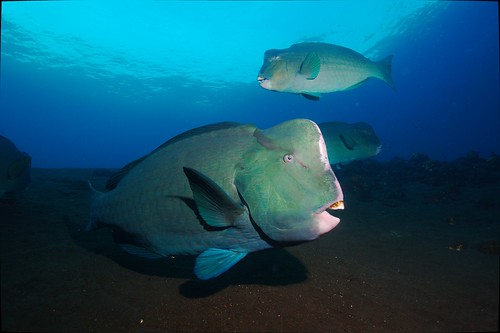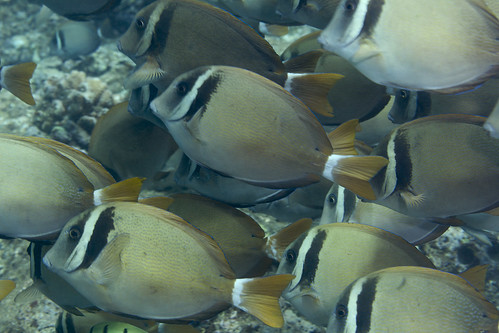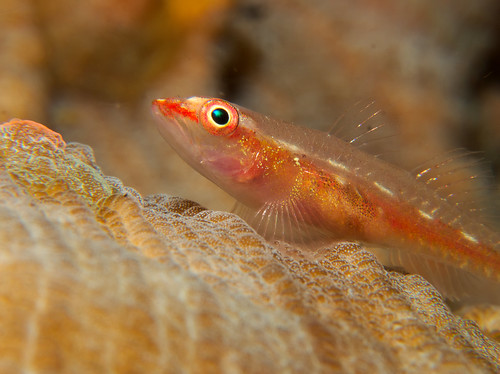
Coral Reefs Lecture Notes
These are the lecture notes for my class on coral reef biology at Silliman University; Like my fish biology lecture notes, these are more than a list of papers and links, and much less than a proper textbook. These notes explain the flow of my course, and I have added a few sentences to each section explaining why the insights and facts presented in the papers and links are important for an understanding of coral reefs. If you start with my notes and then read the papers, you will get a decent overview over coral and coral reef biology, aided by quality scientific literature, some of it very recent – at least I hope so! Many thanks to my students, several of whom have pointed out papers to me which are included in this summary.
Naturally, I had to make a selection from a large body of very good science. I will have omitted some things which some researchers will deem very important. If you let me know what you think I missed, please let me know, I’d be happy to append.
I am still adding material here regularly; check back soon!.
A Large Scale View – – Humans and Reefs – Evolution – Coral Biology – Coral Reef Ecology – Threats to Reefs – Exercises
Coral Reefs – a Large Scale View
Coral reefs are large underwater structures built mainly be the skeletons of hard corals. An excellent introduction into reefs with a biological origin is on Veron’s Corals of the World page. Since Charles Darwin’s insight about the development of reefs we know that typically coral reefs progress from fringing reefs, when they hug the coastline, to barrier reefs, with a significant lagoon between the landmass and the reef, to atolls, where the land has subsided, and a ring of reef remains. This animation shows the process:

Let’s look at some examples. This is a fringing reef along the Big Island of Hawaii:
This is the famous Great Barrier Reef in Australia – note the vastly different spatial scale. This reef streteches along half a continent:
The Philippines are home to a very unusual type of reef, a double-barrier reef. Only six of these exist in the world, this one is located in northern Bohol:
The two barrieres were formed at about the same time, likely due to strong currents paralell to shore, as outlined here:
Grobe, H., Willkom, H., & Wefer, G. (1985). Internal structure and origin of the double reefs of north Bohol and the Olango Reef Flat (Philippines). The Philippine Scientist, 22, 83-94.
And this is Midway atoll in the northwestern Hawaiian islands, belonging to the same island chain as the Big Island, but being geologically much older:
Corals can grow without forming reefs, and reefs can be formed by organisms other than corals (bivalves). However, true coral reefs only occur between about 31 degrees south and 33 degrees north, due to the coral’s requirements for clear water and strong sunlights. Let’s look at the northern- and southernmost known coral reefs:
The southernmost coral reef is Lord Howe island, belonging to Australia.
Humans and Coral Reefs
Humans have interacted with coral reefs ever since they left their African savannah homeland. Coral reefs provide ample protein in the form of fish, to this day to a lareg part of the world’s population. Tourism has become an increasingly profitable way to use coral reefs.
To me, one of the most fascinating chapters of human history is the Austronesian settlement of the vast expanses of the Pacific and Indian oceans. Peoples with stone age-technology settled an area from Madagascar to Easter Island! Let’s look at this map from Wiki. Note that it shows about a third of the planet, settled by using outrigger sailboats!

This paper outlines the cultural evolution of the Austronesian outrigger boat, from its origins as a float, then double hull boat to its more sophisticated versions in Micronesia and Southeast Asia:
Coral Evolution
Corals are, when solely considering their anatomy, “simple” animals, with a cup-shaped basic bauplan, with tentacles around the mouth. They are cnidarians, a phylum which also includes jellyfish and anemones.
When did corals emerge in the evolution of animal life on Earth? During the Cambrian, and not during the preceding Ediacaran period. The very early animal (Vendobiont) Charina was not a soft coral!
The difference in growth patterns between the Vendobionts and sea pens is outline in the paper listed below. In addition, sea pens are actually rather modern, derived soft corals, specialized for thriving in soft mud bottom habitats.
A very nicely preserved anemone – a relative of hard corals – is already documented from the Cambrian, showing that this clade of cnidarians was already fully developed that early in animal evolution. The authors conclude:
The features found in the present fossils fall within the morphological spectrum of modern Hexacorallia excluding Ceriantharia, and thus Eolympia pediculata could be a stem member for this group. The fossils also demonstrate that basic features characterizing modern hexacorallians such as bilateral symmetry and the reproductive system have deep roots in the Early Cambrian.
There is an excellent overview over the evolution of reefs, and of the corals which formed some (this significantly changed over geological time!) of them on the Corals of the World page. A key parameter in coral evolution is their symmetry, as seen from looking at the polyp cup from above. Also, UCM Berkeley has an excellent outline of the macro-evolution of scleratinian hard corals (6x symmetry) and their close relatives, the soft corals (8x symmetry), anemones, tube anemones/black corals, corallimorphs, and zoanthids. The Heliolitids, Rugosae and Tabulate (with a 4x symmetry) corals are extinct and formed reefs in the Paleozoic.
An important insight is that while coral reefs have been around since the Paleozoic, modern scleratinian corals are in fact a young group, only taking off in importance in the Mesozoic.
Finally, a new paper on the evolution of hard corals and the anthozoan relatives just came out which outlines in great detail how they evolved, and how that evolution was driven by catastrophic global events affecting reefs:
To quote the authors:
Pulses of diversification in anthozoans follow mass extinctions and reef crises, with sea anemones and proteinaceous corals filling empty niches as tropical reef builders went extinct. Changing environmental conditions will likely diminish aragonitic reef-building scleractinians, but the evolutionary history of the Anthozoa suggests other groups will persist and diversify in their wake.
The Biology of the Coral Animal
This section of the course covers the biology of the coral animal – its biological features which make it special, such as reef building by calcium carbonate fixation, the harboring of symbionts, and its stinging cells, a special type of cells corals share with all cnidarians.
Basic Anatomy
Again, the Corals of the World page is an excellent source for information on basic hard coral anatomy, with a lot of excellent micrographs of the soft and skeletal structural elements. Please read this section carefully!
Stinging Cells
The presence of stinging cells, nematocysts, is shared among all cnidarians, jellyfish, anemones, corals and their relatives. These cells are equipped with what is a specialized derivative of the Golgi/secretion apparatus present in all eukaryotic cells. Osmotic pressure and specialized proteins create a powerful spear which impales the coral’s prey.
A good description of the fast and extremely powerful nematocyst mechanism is outlined here:
A good review of nematocyst biology, and the harpooning mechanism, plus nemoatocyst phylogeny is here:
Notably, free-swimming jellyfish which have no hard skeleton to protect them have a much more diverse set of nematocysts, with different sizes and types of molecular harpoons.
The toxins which cnidarians use are diverse, and act in combination with each other. There is a wide range of potencies in cnidarian toxins, spread over cnidarian phylogeny. These venoms contain enzymes, potent pore forming toxins, and neurotoxins, as explained in detail in:
Symbionts
One of the key features which makes hard corals so extremely successful organisms is their symbiosis with unicellular algae, which turns them into hybrid animals/plants, so-called “Holobionts”.
The algae are related to free-living dinoflagellates. They receive protection from predation by existing within the tissues of heavily fortified scleratinian corals (with solid skeletons), and in turn provide the corals with sugars. There is a strong mutual benefit between hard corals and their symbiotic algae.
Recently, a number of genomes of these symbiotic algae had been sequenced. This has led to insights in how many different lineages of symbiodinium exist, and what genes are selected for in the course of the symbiosis.
It turns out that some of the sun-screen like chemicals used by corals, mycosporine-like amino acids (MAAs), moved evolutionarily from the corals to the dinoflagellates. A marked increase in immune-system complexity is something we see in hard coral genomes. this is likely serving the more complex cellular interaction with the symbiodinium cells.
The coral innate immunity repertoire is notably more complex than that of the sea anemone:
Calcium Carbonate Fixation
Another key ability in the ecological success of hard corals is their ability to fixate calcium carbonate. This is the mineral which
A key difference between the CaCO3 fixation in present day corals, and the process in Paleozoic corals is that present day corals fixate aragonite, whereas extinct corals used to fixate calcite. These are minerals with different atomic geometries, even though both are CaCO3.
The respiration of the coral polyp, the HCO3- in the seawater, and the CaCO3 fixation all play their part in an integrated cycle of coral carbon metabolism. This is a very well illustrated review of the topic:
Please study their figure 4 in detail:

Nervous System and Signaling
Corals have simpler nervous systems than mammals or insects, but the nevertheless have a network of specialized nerve cells (neurons) spanning their entire bodies. Interestingly, these nervous systems cross individual polyps, and cover complete colonies.
The data situation on coral nervous systems is not great – se we ran simulations a few years ago in our study of coral nervous system connectivity. The types of activity propagation observed in nature work with a specific set or parameters:
Corals also signal between themselves and other organisms – such as gobies! This interesting paper describes how hard corals summon gobies to trim seaweed which might otherwise overgrow the corals. The gobies protect their host corals, and become more toxic due to the chemicals in the seaweed:
Reproduction
Corals can reproduce sexually and asexually. In asexual reproduction, the colonies branch out. In sexual reproduction, gametes, sperm and egg cells, fertilize to give rise to a planula larva which then first spends time in the water column, and then settles on an appropriate reef surface. Some species of corals are brooders, where the planulae develop inside the parent polyps.
Again, Corals of the World provides an excellent intro to the topic.
An important point when it comes to coral reproduction is the ability of coral larvae to travel large distances with ocean currents. A larva will sometimes settle many kilometers away from where its parents grew. How many is “many”? Molecular methods not unlike “paternity tests” in humans can give us answers. In this study, the connectivity between corals on different reefs on the Atlantic coast of Brazil is investigated with such methods. It’s worth studying their methods in detail, also note the very intuitive presentation of their data.
Coral Reef Ecology
The next section covers the syn-ecology of coral reefs, the interactions of corals with the other invertebrates and the fishes which they share their reefs with.
Please have a good look at this album featuring many groups of important coral reef fishes:
Corals and Fishes – Phases in Reefs
Herbivorous fishes and grazing sea urchins remove macroalgae from coral reefs. This gives corals space to thrive. In turn, corals provide the 3d structure for fish to hide from predators. This is a positive feedback cycle. It can be broken – if corals are destroyed by catastrophic events like a typhoon, the reef can enter an alternative “phase”: algae dominated, with few corals and grazing reef fishes.
This biphasic pattern might not be existing in all coral reefs, but the two alternative states seem to exist in some reef systems:
Schmitt, R. J., Holbrook, S. J., Davis, S. L., Brooks, A. J., & Adam, T. C. (2019). Experimental support for alternative attractors on coral reefs. Proceedings of the National Academy of Sciences of the United States of America, 116(10), 4372–4381.
Briggs, C. J., Adam, T. C., Holbrook, S. J., & Schmitt, R. J. (2018). Macroalgae size refuge from herbivory promotes alternative stable states on coral reefs. PLoS ONE, 13(9), 1–14.
Corals and Fishes – Different Types of Grazers
Parrotfishes and surgeonfishes are quite different in their choice of algae which they devour. This is grounded in their evolution and jaw/digestive system anatomy, and has significant ecological consequences. Think of surgeonfishes as the grazing cows of the reef, feeding on tough, hard to digest filamentous algae. In contrast, parrot fishes feed on cyanobacterial “superfood” (like the Spirulina marketed as a health supplement for humans), which is rich in protein and energy-dense fatty acids. To get to these superfood algae, they need their powerful beaks.
Parrotfish (top), school of surgeonfish (bottom):
Clements, K. D., German, D. P., Piché, J., Tribollet, A., & Choat, J. H. (2017). Integrating ecological roles and trophic diversification on coral reefs: Multiple lines of evidence identify parrotfishes as microphages. Biological Journal of the Linnean Society, 120(4), 729–751.
Corals and Fishes – Sharks, Inverse Food Pyramids, Mesopredators
On remote reefs in the central tropical Pacific Ocean, reefs were found with great shark biomasses. Especially an expedition to the Line Islands in the nation of Kiribati showed this very clearly, but also places in French Polynesia and other remote areas have massive shark numbers. Why is this the case? Is this a measurement artefact? What theoretical predictions can we make regarding such “inverted trophic pyramids”?
Ferretti, F., Worm, B., Britten, G. L., Heithaus, M. R., & Lotze, H. K. (2010). Patterns and ecosystem consequences of shark declines in the ocean. Ecology Letters, 13(8), 1055–1071.
Mourier, J., Maynard, J., Parravicini, V., Ballesta, L., Clua, E., Domeier, M. L., & Planes, S. (2016). Extreme Inverted Trophic Pyramid of Reef Sharks Supported by Spawning Groupers. Current Biology, 26(15), 2011–2016.
Nadon, M., Williams, I., & Baum, J. (2018). How many sharks are there in near-pristine coral reef ecosystems? Response to Bradley et al. Scientific Reports, December.
Sandin, S. A., Smith, J. E., DeMartini, E. E., Dinsdale, E. A., Donner, S. D., Friedlander, A. M., Konotchick, T., Malay, M., Maragos, J. E., Obura, D., Pantos, O., Paulay, G., Richie, M., Rohwer, F., Schroeder, R. E., Walsh, S., Jackson, J. B. C., Knowlton, N., & Sala, E. (2008).
Baselines and degradation of coral reefs in the Northern Line Islands. PLoS ONE, 3(2).
Stevenson, C., Katz, L. S., Micheli, F., Block, B., Heiman, K. W., Perle, C., Weng, K., Dunbar, R., & Witting, J. (2007). High apex predator biomass on remote Pacific islands. Coral Reefs, 26(1), 47–51.
Simpfendorfer, C. A., & Heupel, M. R. (2016). Ecology: The Upside-Down World of Coral Reef Predators. Current Biology, 26(15), R708–R710. https://doi.org/10.1016/j.cub.2016.05.074
Corals and Fishes – Cryptobenthic Reef Fishes
Gobies, blennies, cardinalfishes and a few other groups of mainly small, bottom- or crevice-living fishes are so numerous that despite their small sizes, they represent an important aspect of the coral reef ecosystem. Even though every individual goby is small and short lived, their sheer numbers and high turnover make them an important food source for mid-sized predatory fishes, and hence a link from the primary producers/small invertebrates to the upper echelons of the coral reef food web.
Depczynski, M., & Bellwood, D. R. (2003). The role of cryptobenthic reef fishes in coral reef trophodynamics. Marine Ecology Progress Series, 256, 183–191.
Brandl, S. J., Goatley, C. H. R., Bellwood, D. R., & Tornabene, L. (2018). The hidden half: ecology and evolution of cryptobenthic fishes on coral reefs. Biological Reviews, 93(4), 1846–1873.
Corals and Invertebrates – COTS and Drupella
The crown-of-thorns seastar, and the mollusk Drupella are naturally occurring (not invasive) species in coral reefs which prey on living hard corals. Under certain conditions, these animals’ populations can grow unusually high, and they can cause damage to coral reefs.
Interestingly, not one but 4 species of COTS starfish exist:
COTS may be slow, but show more sophisticated spatial behavior than one would naively assume:
Ling S, Cowan Z, Boada J. Flukes B, Pratchett M. (2020). ‘Homing behaviour by destructive crown-of-thorns starfish is triggered by local availability of coral prey’. Proceedings of the Royal Society B. DOI: 10.1098/rspb.2020.1341
The Australian Institute of Marine Science has a detailed document about COTS management available.
Unusual Reefs – Mesophotic and Murky
Mesophotic reefs, in the zone 30 to 150 meters from the water surface, and the reduced light levels in these reefs, as well as the reduced effect of waves and surge, make them places unlike the shallow reefs snorkelers and scuba divers are more familiar with. Recent years have seen an increased interest in these mesophotic reefs. Can they possibly even act as refuges for marine animals which are facing climate change and over-exploitation in the shallows? This seems unlikely for most species, since both corals and reef fishes are in most cases specialized for life at very particular depths. this includes the growth forms in corals, the symbiotic algae in clorals, and the fin shape in fishes.
Einbinder, S., Gruber, D. F., Salomon, E., Liran, O., Keren, N., & Tchernov, D. (2016). Novel adaptive photosynthetic characteristics of mesophotic symbiotic microalgae within the reef-building coral, Stylophora pistillata. Frontiers in Marine Science, 3(OCT), 1–9.
Rocha, L. A., Pinheiro, H. T., Shepherd, B., Papastamatiou, Y. P., Luiz, O. J., Pyle, R. L., & Bongaerts, P. (2018). Mesophotic coral ecosystems are threatened and ecologically distinct from shallow water reefs. Science, 361(6399), 281–284.
Pinheiro, H. T., Shepherd, B., Castillo, C., Abesamis, R. A., Copus, J. M., Pyle, R. L., Greene, B. D., Coleman, R. R., Whitton, R. K.,
Thillainath, E., Bucol, A. A., Birt, M., Catania, D., Bell, M. V., & Rocha, L. A. (2019). Deep reef fishes in the world’s epicenter of marine biodiversity. Coral Reefs, 38(5), 985–995.
Bridge, T. C. L., Luiz, O. J., Coleman, R. R., Kane, C. N., & Kosaki, R. K. (2016). Ecological and morphological traits predict depth-generalist fishes on coral reefs. Proceedings of the Royal Society B: Biological Sciences, 283(1823).
Another reef type not often seen is the reef near the mouth of the Amazon river – a river which moves incredible amounts of sediments, a condition which is normally considered absolutely unsuitable for coral reefs:
This blog post introduces the rodoliths, which play such a prominent role in the Great Amazon Reef System.
Threats to Coral Reefs
The last section covers the – unfortunately – increasing anthropogenic threats to coral reefs, and possible ways to avert these threats.
Climate Change & Ocean Acidification
Without any doubt, anthropogenic climate is the most severe threat to coral reefs in our times. Sea-surface temperatures are increasing, which leads to a phenomenon called “coral bleaching”, a loss of symbionts. Also, ocean acidification (already discussed in the section dealing with carbonate fixation) makes it energetically harder to fixate carbonate and to build coral skeletons.
I made this brief explainer video on the topic, with footage from an area of ocean where the pH has already become very acidic, due to intensive fish farming nearby:
Run-off, Coastal Development, Nutrient Influx
A number of factors stress coral reefs on a local scale. They interact with global climate change to determine how quick, and if at all, a reef recovers from bleaching events or typhoons. The main priority in coral reef conservation is to halt anthropogenic climate change, but that is sadly not a trivial task, with lots of political inertia working against it.
In the face of climate change happening, reducing local stressors which synergistically interact with climate change, is of high priority.
COTS and Biogenic Threats
We have covered the crown-of-thorns starfish and its effects already in the previous section of the class (see comments above).
Artificial Reefs, Coral Gardening, Seeding
Many efforts world-wide concentrate on creating artificial reef structures, on transplanting corals, and on seeding reefs with coral larvae. How effective are these approaches, when can and should they be used, and what are their limits?
One thing is certain, and that many of these efforts don’t scale well. The coral reefs of the world are massive structures, in the case of the GBR lining half the eastern coastline of a whole continent, and typically the areas affected by coral restoration efforts are measured in hectares.
The coral reef biologists at De La Salle university in Manila wrote up a nice guide to coral gardening, detailing the difficulties, and the legal situation in the Philippines.
Exercises
1. Snorkel above a coral reef and observe the composition of the seafloor/the benthic organisms. What damage to the benthic cover can you detect? What is the cause of this damage?
2. Snorkel above a coral reef and observe the fish fauna associated with the reef. Concentrate on 1 or 2 families of reef fishes. How many species can you identify? Use a slate to take notes and draw fish species you are not familiar with, to look them up in ID books later.
3. Use bioinformatics software tools to investigate the genomes of a scleratinian coral and a Symbiondinium algae. It is known that there has been no horizontal transfer of genes. But has there also been no horizontal transfer of non-coding genetic elements?
4. Detonate a thermonuclear device above a coral reef. Observe: what are the effects of the device on the corals and on the associated fish fauna? What are the socio-economic effects of such a detonation?
Coral Reef Organisms ID Quiz/Exercise
- Invertebrates: ID all the echinoderms in these images. Bonus: can you identify the behavior some of them are engaged in?
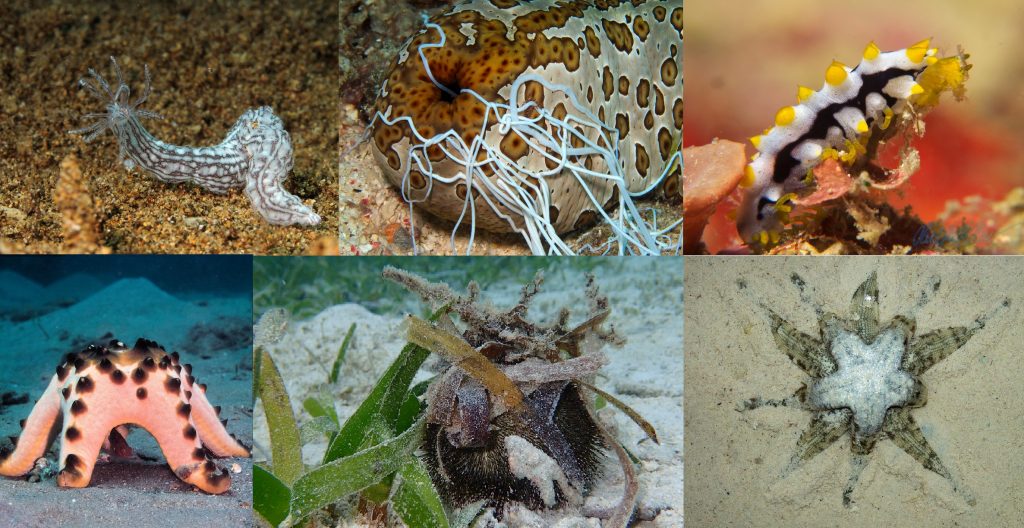
- Corals: Look at this brief video of a snorkel in Dauin, Negros Oriental, Philippines. ID at least 5 corals to the genus level (you can stop the video, and use screen shots, and annotate them – write on the screen shot images). Note the great diversity of corals seen in only 18 seconds of video!
- Fishes: ID these coral-reef associated fishes to the species level, and note what the kind of interaction with corals, or their role in the coral reef ecosystem is.
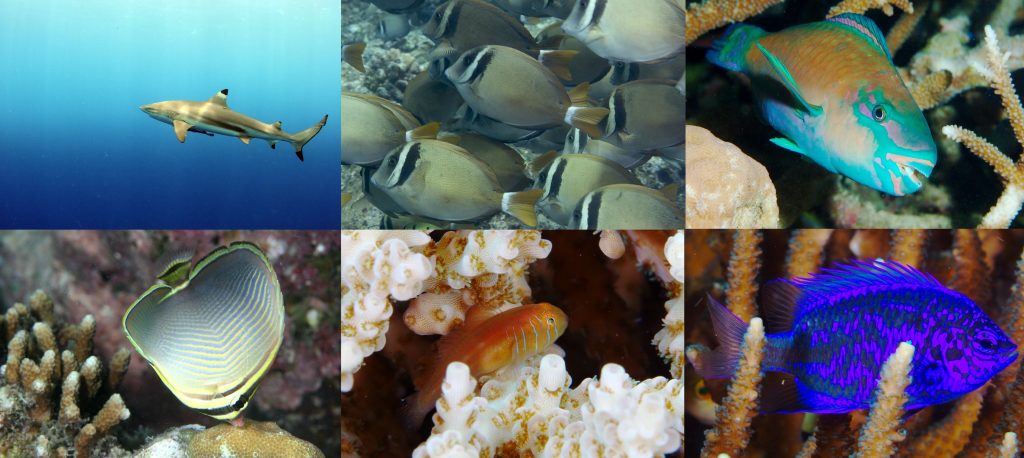
4. Deadly Sunscreen? In many dive resorts and beach-wear boutiques you can buy “Reef Save Sunscreen” these days. The assumption is that regular sunscreen contains chemicals which harm corals when used by swimmers near corals. But, is this supported by scientific evidence? What are the papers arguing for or against this harmful effect? Do you find information outside of the pier-reviewed literature about this topic? How reliable is it? Do this as a team exercise, and be prepared to defend your conclusions.
